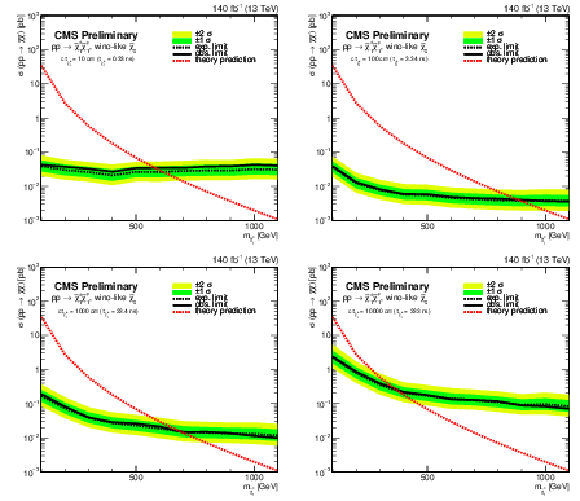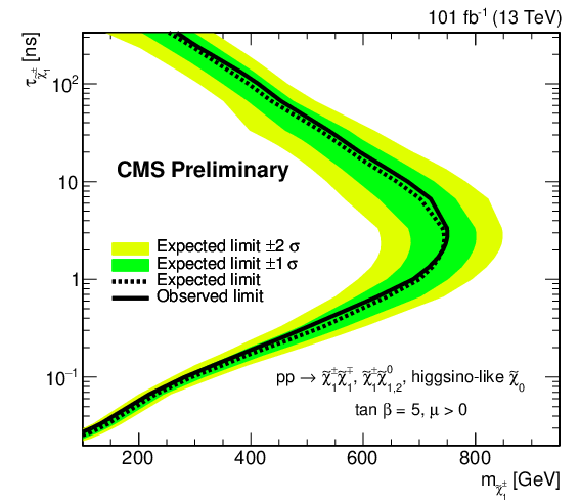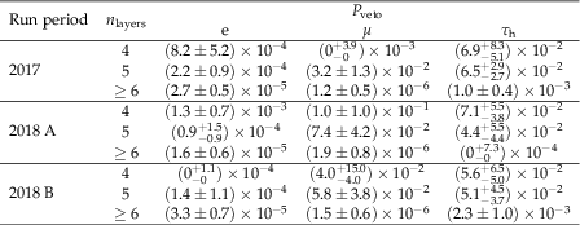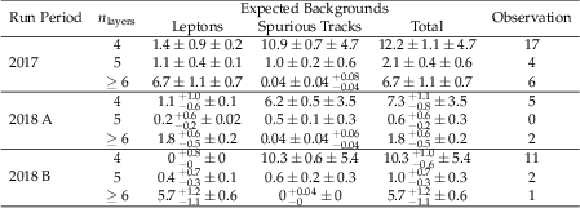

Compact Muon Solenoid
LHC, CERN
| CMS-PAS-EXO-19-010 | ||
| Search for disappearing tracks in proton-proton collisions at $\sqrt{s} = $ 13 TeV | ||
| CMS Collaboration | ||
| January 2020 | ||
| Abstract: A search is presented for long-lived charged particles that decay within the silicon tracker of the CMS detector. Such particles can produce a "disappearing track" signature, identified as an isolated track with no associated hits in the muon detectors, little calorimeter energy deposits, and missing hits in the outermost layers of the silicon tracker. The search is performed in proton-proton collision data recorded by the CMS experiment at a center-of-mass energy of 13 TeV during 2017 and 2018, corresponding to an integrated luminosity of 101 fb$^{-1}$. The observation of 48 events is consistent with the estimated background of 47.8 $_{-2.3}^{+2.7}$ (stat) $\pm$ 8.1 (syst) events. Upper limits are set on chargino production in the context of an anomaly-mediated supersymmetry breaking model for purely wino- and higgsino-like neutralino mixing scenarios. At 95% confidence level, chargino masses in the higgsino case are excluded below 750 GeV (175 GeV) for a lifetime of 3 (0.05) ns. In the wino case, the results of the search in the 2017 and 2018 data-taking periods are combined with the previous CMS result in the 2015 and 2016 periods, forming the full Run 2 results. At 95% confidence level, chargino masses in the wino case are excluded below 884 GeV (474 GeV) for a lifetime of 3 (0.2) ns. | ||
|
Links:
CDS record (PDF) ;
CADI line (restricted) ;
These preliminary results are superseded in this paper, PLB 806 (2020) 135502. The superseded preliminary plots can be found here. |
||
| Figures | |

png pdf |
Figure 1:
The expected and observed 95% CL upper limits on the cross section for direct production of charginos as a function of chargino mass for chargino lifetimes of 0.33, 3.3, and 33 ns, for a purely wino-like LSP and with their branching fraction to $ {\tilde{\chi}_1^0}\pi ^\pm $ set to 100%. The direct chargino production cross section includes both $ {\tilde{\chi}_1^0} {\tilde{\chi}^\pm _{1}} $ and $ {\tilde{\chi}_1^\pm} {\tilde{\chi}_1^\mp}$ production in roughly a 2:1 ratio for all chargino masses considered. The dashed red line indicates the theoretical prediction for the AMSB model. The results of the search in the 2017 and 2018 data-taking periods are combined with previous results [9] in 2015 and 2016, forming the full Run 2 results. |

png pdf |
Figure 1-a:
The expected and observed 95% CL upper limits on the cross section for direct production of charginos as a function of chargino mass for chargino lifetimes of 0.33 ns, for a purely wino-like LSP and with their branching fraction to $ {\tilde{\chi}_1^0}\pi ^\pm $ set to 100%. The direct chargino production cross section includes both $ {\tilde{\chi}_1^0} {\tilde{\chi}^\pm _{1}} $ and $ {\tilde{\chi}_1^\pm} {\tilde{\chi}_1^\mp}$ production in roughly a 2:1 ratio for all chargino masses considered. The dashed red line indicates the theoretical prediction for the AMSB model. The results of the search in the 2017 and 2018 data-taking periods are combined with previous results [9] in 2015 and 2016, forming the full Run 2 results. |

png pdf |
Figure 1-b:
The expected and observed 95% CL upper limits on the cross section for direct production of charginos as a function of chargino mass for chargino lifetimes of 3.3 ns, for a purely wino-like LSP and with their branching fraction to $ {\tilde{\chi}_1^0}\pi ^\pm $ set to 100%. The direct chargino production cross section includes both $ {\tilde{\chi}_1^0} {\tilde{\chi}^\pm _{1}} $ and $ {\tilde{\chi}_1^\pm} {\tilde{\chi}_1^\mp}$ production in roughly a 2:1 ratio for all chargino masses considered. The dashed red line indicates the theoretical prediction for the AMSB model. The results of the search in the 2017 and 2018 data-taking periods are combined with previous results [9] in 2015 and 2016, forming the full Run 2 results. |

png pdf |
Figure 1-c:
The expected and observed 95% CL upper limits on the cross section for direct production of charginos as a function of chargino mass for chargino lifetimes of 33 ns, for a purely wino-like LSP and with their branching fraction to $ {\tilde{\chi}_1^0}\pi ^\pm $ set to 100%. The direct chargino production cross section includes both $ {\tilde{\chi}_1^0} {\tilde{\chi}^\pm _{1}} $ and $ {\tilde{\chi}_1^\pm} {\tilde{\chi}_1^\mp}$ production in roughly a 2:1 ratio for all chargino masses considered. The dashed red line indicates the theoretical prediction for the AMSB model. The results of the search in the 2017 and 2018 data-taking periods are combined with previous results [9] in 2015 and 2016, forming the full Run 2 results. |

png pdf |
Figure 1-d:
The expected and observed 95% CL upper limits on the cross section for direct production of charginos as a function of chargino mass for chargino lifetimes of 333 ns, for a purely wino-like LSP and with their branching fraction to $ {\tilde{\chi}_1^0}\pi ^\pm $ set to 100%. The direct chargino production cross section includes both $ {\tilde{\chi}_1^0} {\tilde{\chi}^\pm _{1}} $ and $ {\tilde{\chi}_1^\pm} {\tilde{\chi}_1^\mp}$ production in roughly a 2:1 ratio for all chargino masses considered. The dashed red line indicates the theoretical prediction for the AMSB model. The results of the search in the 2017 and 2018 data-taking periods are combined with previous results [9] in 2015 and 2016, forming the full Run 2 results. |

png pdf |
Figure 2:
The expected and observed constraints on chargino lifetime and mass for a purely wino-like LSP in the context of AMSB, where the chargino lifetime is freely varied. The chargino branching fraction is set to 100% for $ {\tilde{\chi}_1^\pm}\to {\tilde{\chi}_1^0} {\pi ^\mathrm {{\pm}}}$. The region to the left of the curve is excluded at 95% CL. The results of the search in the 2017 and 2018 data-taking periods are combined with previous results [9] in 2015 and 2016, forming the full Run 2 results. |

png pdf |
Figure 3:
The expected and observed constraints on chargino lifetime and mass for a purely higgsino-like LSP in the context of AMSB, where the chargino lifetime is freely varied. The chargino branching fraction is set to 95.5% for $ {\tilde{\chi}_1^\pm}\to {\tilde{\chi}_{1,2}^0} {\pi ^\mathrm {{\pm}}}$, 3% for $ {\tilde{\chi}_1^-}\to {\tilde{\chi}_{1,2}^0} \mathrm{ e \bar{\nu}_{e}}$, and $1.5%$ for $ {\tilde{\chi}_1^-}\to {\tilde{\chi}_{1,2}^0}\mu \bar{\nu}_{\mu}$, with equal branching fractions and production cross sections between $ {\tilde{\chi}_1^0}$ and $ {\tilde{\chi}_2^0}$. The region to the left of the curve is excluded at 95% CL. |
| Tables | |

png pdf |
Table 1:
Summary of estimated values of $P_{\mathrm {veto}}$. The uncertainties shown represent only the statistical uncertainties. |

png pdf |
Table 2:
Summary of the systematic uncertainties for each background estimate. The values listed represent the average value across all data-taking periods, and the listed signs indicate the range of each uncertainty. |

png pdf |
Table 3:
Summary of the systematic uncertainties in the signal efficiencies. The values listed represent the average value across all chargino masses and lifetimes considered. These values are averaged over all data-taking periods, and between the wino-like and higgsino-like cases. |

png pdf |
Table 4:
Summary of the estimated backgrounds and the observation. The first uncertainty represents the statistical uncertainty and the second the systematic. |
| Summary |
|
A search has been presented for long-lived, charged particles that decay within the CMS detector and produce the disappearing track signature. In a sample of proton-proton collision data recorded in 2017 and 2018 corresponding to an integrated luminosity of 101 fb$^{-1}$, 48 events are observed, which is consistent with the expected background from standard model processes of 47.8 $ _{-2.3}^{+2.7}$ (stat) $\pm$ 8.1 (syst) events. These results are applicable to any BSM scenario capable of producing this signature, and in combination with the previous CMS search [9] are the first such results on the complete Run 2 LHC data set, corresponding to a total integrated luminosity of 140 fb$^{-1}$. Two interpretations of these results are provided in the context of anomaly-mediated supersymmetry breaking. In the case of a purely higgsino-like LSP, AMSB charginos are excluded up to a mass of 750 GeV (175 GeV) for a mean proper lifetime of 3 (0.05) ns using the 2017 and 2018 data sets. In the case of a purely wino-like LSP, AMSB charginos are excluded up to a mass of 884 GeV (474 GeV) for a mean proper lifetime of 3 (0.2) ns using the full Run 2 LHC data set. These constraints extend the limits set by the previous CMS search [9] for disappearing tracks, and greatly improve sensitivity to shorter particle lifetimes by introducing two additional search categories. For AMSB chargino lifetimes above approximately 0.1 ns, this search places the most stringent constraints on direct chargino production with a purely wino-like LSP using the disappearing track signature. For a purely higgsino-like LSP, these constraints are the first to be published using this signature. |
| References | ||||
| 1 | C. H. Chen, M. Drees, and J. F. Gunion | A Nonstandard string / SUSY scenario and its phenomenological implications | PRD 55 (1997) 330--347 | hep-ph/9607421 |
| 2 | M. Ibe, S. Matsumoto, and T. T. Yanagida | Pure Gravity Mediation with $ m_{3/2} = $ 10 - 100 TeV | PRD 85 (2012) 095011 | 1202.2253 |
| 3 | L. J. Hall, Y. Nomura, and S. Shirai | Spread Supersymmetry with Wino LSP: Gluino and Dark Matter Signals | JHEP 01 (2013) 036 | 1210.2395 |
| 4 | A. Arvanitaki, N. Craig, S. Dimopoulos, and G. Villadoro | Mini-Split | JHEP 02 (2013) 126 | 1210.0555 |
| 5 | M. Citron et al. | End of the CMSSM coannihilation strip is nigh | PRD 87 (2013) 036012 | 1212.2886 |
| 6 | G. F. Giudice, M. A. Luty, H. Murayama, and R. Rattazzi | Gaugino mass without singlets | JHEP 12 (1998) 027 | hep-ph/9810442 |
| 7 | L. Randall and R. Sundrum | Out of this world supersymmetry breaking | NPB 557 (1999) 79 | hep-th/9810155 |
| 8 | ATLAS Collaboration | Search for long-lived charginos based on a disappearing-track signature in pp collisions at $ \sqrt{s}= $ 13 TeV with the ATLAS detector | JHEP 06 (2018) 022 | 1712.02118 |
| 9 | CMS Collaboration | Search for disappearing tracks as a signature of new long-lived particles in proton-proton collisions at $ \sqrt{s} = $ 13 TeV | JHEP 08 (2018) 016 | CMS-EXO-16-044 1804.07321 |
| 10 | CMS Collaboration | CMS Technical Design Report for the Pixel Detector Upgrade | ||
| 11 | CMS Collaboration | Performance verification of the CMS Phase-1 Upgrade Pixel detector | JINST 12 (2017) C12010 | 1710.03842 |
| 12 | CMS Collaboration | Description and performance of track and primary-vertex reconstruction with the CMS tracker | JINST 9 (2014) P10009 | CMS-TRK-11-001 1405.6569 |
| 13 | CMS Collaboration | The CMS trigger system | JINST 12 (2017) P01020 | CMS-TRG-12-001 1609.02366 |
| 14 | CMS Collaboration | The CMS experiment at the CERN LHC | JINST 3 (2008) S08004 | CMS-00-001 |
| 15 | CMS Collaboration | CMS luminosity measurement for the 2017 data-taking period at $ \sqrt{s} = $ 13 TeV | CMS-PAS-LUM-17-004 | CMS-PAS-LUM-17-004 |
| 16 | CMS Collaboration | CMS luminosity measurement for the 2018 data-taking period at $ \sqrt{s} = $ 13 TeV (Publication awaiting CWR) | CMS-PAS-LUM-18-002 | |
| 17 | T. Sjostrand et al. | An Introduction to PYTHIA 8.2 | CPC 191 (2015) 159 | 1410.3012 |
| 18 | NNPDF Collaboration | Parton distributions for the LHC Run II | JHEP 04 (2015) 040 | 1410.8849 |
| 19 | CMS Collaboration | Extraction and validation of a new set of CMS PYTHIA8 tunes from underlying-event measurements | CMS-PAS-GEN-17-001 | CMS-PAS-GEN-17-001 |
| 20 | F. E. Paige, S. D. Protopopescu, H. Baer, and X. Tata | ISAJET 7.69: A Monte Carlo event generator for pp, anti-p p, and e+e- reactions | hep-ph/0312045 | |
| 21 | M. Ibe, S. Matsumoto, and R. Sato | Mass splitting between charged and neutral winos at two-loop level | PLB 721 (2013) 252 | 1212.5989 |
| 22 | B. Fuks, M. Klasen, D. R. Lamprea, and M. Rothering | Gaugino production in proton-proton collisions at a center-of-mass energy of 8 TeV | JHEP 10 (2012) 081 | 1207.2159 |
| 23 | B. Fuks, M. Klasen, D. R. Lamprea, and M. Rothering | Precision predictions for electroweak superpartner production at hadron colliders with $ \sc $ Resummino | EPJC 73 (2013) 2480 | 1304.0790 |
| 24 | P. M. Nadolsky et al. | Implications of CTEQ global analysis for collider observables | PRD 78 (2008) 013004 | 0802.0007 |
| 25 | A. D. Martin, W. J. Stirling, R. S. Thorne, and G. Watt | Parton distributions for the LHC | EPJC 63 (2009) 189 | 0901.0002 |
| 26 | J. Butterworth et al. | PDF4LHC recommendations for LHC Run II | JPG 43 (2016) 023001 | 1510.03865 |
| 27 | CMS Collaboration | Search for top-squark pair production in the single-lepton final state in pp collisions at $ \sqrt{s} = $ 8 TeV | EPJC 73 (2013) 2677 | CMS-SUS-13-011 1308.1586 |
| 28 | GEANT4 Collaboration | GEANT4: A Simulation toolkit | NIMA 506 (2003) 250 | |
| 29 | CMS Collaboration | Particle-flow reconstruction and global event description with the CMS detector | JINST 12 (2017) P10003 | CMS-PRF-14-001 1706.04965 |
| 30 | M. Cacciari, G. P. Salam, and G. Soyez | The anti-$ {k_{\mathrm{T}}} $ jet clustering algorithm | JHEP 04 (2008) 063 | 0802.1189 |
| 31 | M. Cacciari, G. P. Salam, and G. Soyez | FastJet user manual | EPJC 72 (2012) 1896 | 1111.6097 |
| 32 | CMS Collaboration | Performance of reconstruction and identification of $ \tau $ leptons decaying to hadrons and $ \nu_\tau $ in pp collisions at $ \sqrt{s}= $ 13 TeV | JINST 13 (2018), no. 10, P10005 | CMS-TAU-16-003 1809.02816 |
| 33 | CMS Collaboration | Performance of missing transverse momentum reconstruction in proton-proton collisions at $ \sqrt{s} = $ 13 TeV using the CMS detector | JINST 14 (2019) P07004 | CMS-JME-17-001 1903.06078 |
| 34 | CMS Collaboration | Measurements of inclusive W and Z cross sections in pp collisions at $ \sqrt{s}= $ 7 TeV | JHEP 01 (2011) 080 | CMS-EWK-10-002 1012.2466 |
| 35 | Particle Data Group, M. Tanabashi et al. | Review of particle physics | PRD 98 (2018) 030001 | |
| 36 | CMS Collaboration | Muon Tracking Efficiency using Tag and Probe method for 2017 dataset | CDS | |
| 37 | ATLAS Collaboration | Procedure for the LHC Higgs boson search combination in summer 2011 | CMS-NOTE-2011-005 | |
| 38 | T. Junk | Confidence level computation for combining searches with small statistics | NIMA 434 (1999) 435 | hep-ex/9902006 |
| 39 | A. L. Read | Presentation of search results: The CL(s) technique | JPG 28 (Sep, 2002) 2693 | |
| 40 | G. Cowan, K. Cranmer, E. Gross, and O. Vitells | Asymptotic formulae for likelihood-based tests of new physics | EPJC 71 (2011) 1554 | 1007.1727 |

|
Compact Muon Solenoid LHC, CERN |

|

|

|

|

|

|